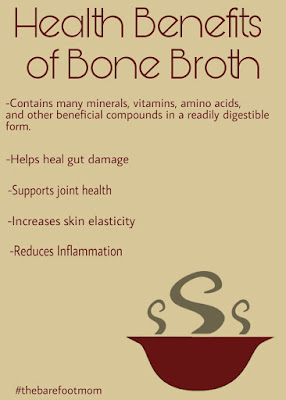Bone broth is an amazing super food that has been a traditional part of the human diet since ancient times.
Bone Broth Health Benefits:
Bone broth contains lots of vitamins, minerals, essential amino acids, glucosamine, and many other beneficial compounds in an easy to digest form. It can sooth cold symptoms and even help heal leaky gut syndrome and IBS. Plus it's delicious and makes an excellent baby food.One of the most amazing benefits of bone broth is it's gut healing capabilities. Bone broth contains high amounts of both collagen and gelatin which are both useful for healing gut damage. Some say there is no scientific evidence to back such claims but The United European Gastrointestinal Journal published a study in 2014 demonstrating the gut healing abilities of gelatin in mice. Bone broth is also a good source of the essential amino acid, L-glutamine which supports gut health by reducing gut inflammation. You can read more about it here and here.
Bone broth's high collagen content makes it excellent for skin, hair, and joints. Studies show collagen improves skin elasticity. Collagen is also helpful in the treatment of joint pain and may help prevent joint deterioration. (source)
In addition to all it's fantastic health benefits, bone broth also makes an excellent base for soups and savory sauces. It can be used in place of stock or broth in any recipe.
My Bone Broth Recipe:
-Prep time: 10 minutes
-Cook time: 8-48 hours
Ingredients:
-2 pounds of bones from a healthy organic and humanely raised source
-1 onion-1 carrot
-A few garlic cloves
-1 teaspoon of fresh or dried rosemary
-2 tablespoons of apple cider vinegar
-Salt and pepper to taste (optional)
Place bones in a large pot and fill with water until the bones are covered. Chop the veggies and add them, the rosemary, salt, pepper, and the vinegar to the pot.
Bring to a full boil, cover with a lid, and then reduce the temperature. Let it simmer for at least 8 hours (longer for added benefits). You'll want to stir and replace any water that has evaporated off every hour or two.
When your finished, remove from heat and pour through a strainer to remove the bones and large chuncks of veggies. And that's it! Now you have bone broth to use in all your favorite recipes.
It can be stored in an airtight container in the fridge for up to 5 days or you can freeze it to use later.
Sources:
http://journals.sagepub.com/doi/abs/10.1177/2050640614520867
https://www.ncbi.nlm.nih.gov/pmc/articles/PMC3006244/
https://www.ncbi.nlm.nih.gov/pmc/articles/PMC2432018/
http://www.jmnn.org/article.asp?issn=2278-1870;year=2015;volume=4;issue=1;spage=47;epage=53;aulast=Borumand
https://www.ncbi.nlm.nih.gov/m/pubmed/18416885/
What's your favorite way to use bone broth?
Follow me on:



Yes! Totally on board with the bone broth train!
ReplyDeleteIt's some awesome stuff :-)
DeleteGluten/dairy/nut/mushroom free too! LOL. I actually have never tried making it, but I remember my husband's grandma making it.
ReplyDeleteIt's definitely a good super food for those with dietary restrictions! Thanks for reading :-)
DeleteWow that is amazing. From now on i will cook using bone broth. Thank you
ReplyDeleteIt really is some awesome stuff! Thanks for reading :-)
DeleteMy mom has been making and having bone broth and she raves about it. My mission for this weekend is to make my own. Thanks for sharing the recipe!
ReplyDeleteIt really is some awesome stuff! Enjoy your bone broth!
DeleteThis sounds great. I’m just not really a broth eater... And I definitely hate dealing with animal bones and all those things. Maybe this would be something my husband could make for us!
ReplyDelete